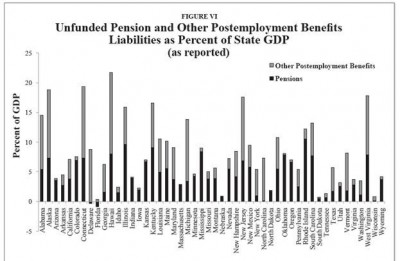The Problem with Pensions
By John Mauldin
A report just out from the Center for Policy Analysis, by Courtney Collins and Andrew J. Rettenmaier (solid academic types from Mercer University and Texas A&M respectively), that indicates that state and local pension funds are drastically underfunded.
I first wrote about public pension problems in 2003, suggesting that pensions would soon be underfunded by $2 trillion, as a long-term secular bear market would dampen returns. Turns out that I am once again proven to be a wild-eyed optimist. Quoting from the executive summary:
"Many state and local government pension plans’ liabilities are calculated using discount rates that are not commensurate with the risk they may pose to taxpayers. Accounting standards allow pension funds to calculate their liabilities using a discount rate comparable to the expected rate of return on the funds’ assets. This typically high discount rate tends to reduce the size of a pension plan’s accrued liabilities. However, pensioners have a durable legal claim to receive their benefits and consequently, it is more appropriate to use a lower discount rate in calculating the plans’ accrued liabilities.
"Due to the use of high discount rates, the liabilities of state and local government pension plans are underestimated. For example, recent reports by the Pew Center on the States and others indicate that assets will cover about 85 percent of the pension benefits owed to participants. But other studies that adopted lower discount rates have found liabilities may actually be 75 percent to 86 percent higher than reported. As a result, taxpayers’ role as insurer may be much greater than anticipated."
You can read the whole report and see how your state is doing at https://www.ncpa.org/sub/dpd/index.php?Article_ID=19634
Turns out that, by the authors’ calculations, state and local pensions are underfunded by $3 trillion (with a T). Of course, some states are much worse off than others. The report has numerous graphs but the following one tells us a lot. It is the unfunded liabilities as a percentage of state GDP.
In the paper (less than 20 pages) they cite the work of Novy-Marx and Rauh and another paper by Biggs. They all use very different methodologies but come up with roughly the same $3 trillion underfunding.
First, understand that in most states the law will not allow for adjustment of pensions. Taxpayers are completely on the hook. That money WILL be found at the expense of either higher taxes or reduced services (such as health care, roads, or police).
Second, the hole is getting deeper each year. Most pensions assume they are going to get an 8% return on their investments. This in a time of a slow economy for years ahead (as I have shown elsewhere), very low bond yields, and a stock market that I think is still in a long-term secular bear market for another 6-7 years, which suggests a continuation of the current sideways, volatile market.
What if instead of getting an 8% return, total returns were 5%? That would mean the hole would be getting deeper by about $75 billion a year. And what if people lived longer, as is clearly the trend, as the actuaries keep changing the longevity tables every few years for the better? (Which for this 60-year old is a very good thing!)
Why use an 8% assumption? Because if you used more conservative numbers, as the academic studies suggest, you would have to make larger current contributions to the pensions, when state and local governments and schools are already in fiscal trouble. So what do the pension plans do? They hire "consultants" who tell them they can expect 8%, as shown by all the nice models and papers that back up their "advice." Note that if you were a consultant who said you should use a 5% discount rate, you would not be hired. Hmmm, where have we seen that phenomenon before?
My friend Paul McCulley (of PIMCO, who I hope to see tonight) quipped that the ratings agencies were supplying fake IDs at a teenage drinking party, when it came to the subprime mortgage ratings. The pension consultants are providing a similar service to their clients, who are told what they want to hear, pay large fees for the privilege, and thereby increase the risk to taxpayers and reduce the current pain for politicians.
This is going to end in tears for many states and municipalities. I mean real tears. Pension funding in some states will be required by law to consume 25-30% or more of tax revenues. That is going to mean much higher taxes or reduced services. I would seriously consider checking how your state and locality are funded. You might not want to retire to a place that is on a collision course with serious pain. Just a thought.
John Mauldin
[email protected]
John Mauldin, Best-Selling author and recognized financial expert, is also editor of the free Thoughts From the Frontline that goes to over 1 million readers each week. For more information on John or his FREE weekly economic letter go to:https://www.frontlinethoughts.com/learnmore.

Comments are closed.